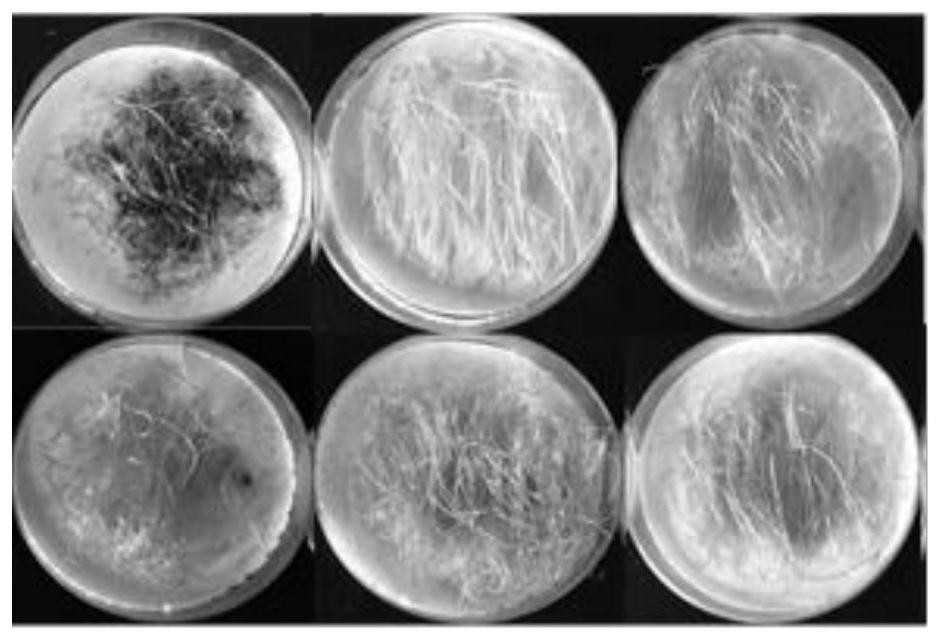Artificially synthesized insect-resistant protein mCry1Ia2 as well as preparation method and applications thereof
A technology of artificial synthesis and anti-insect protein, applied in the fields of genetic engineering and biological control, to achieve the effect of reducing usage, broad application prospects and important economic value
- Summary
- Abstract
- Description
- Claims
- Application Information
AI Technical Summary
Problems solved by technology
Method used
Image
Examples
Embodiment 1
[0057] Example 1 Synthesis of mCry1Ia2 gene
[0058] Through codon optimization, Cry1Ab, Cry1F and Cry1Ie were synthesized (the synthesis work was completed by Jinweizhi (Suzhou) Co., Ltd.), and then by SOE method (1992, Cai Yuyang), the first and second functional domains of Cry1Ab, Cry1F The third functional domain and the three domain fragments of Cry1Ie are spliced together to form a new mCry1Ia2 DNA sequence with six domains, the nucleotide sequence of which is shown in SEQ ID NO.1. It is generally believed that Bt protein is composed of three domains. Domain I includes 250-300 amino acids at the N-terminus of the active insecticidal protein and consists of 7 α-helices, one of which is relatively hydrophobic and is located in the structural domain. The center of I, and the remaining 6 α-helices surround it. It has been shown that it is related to the toxicity of insecticidal proteins. The hydrophobic α-helix has the ability to insert into the midgut cell membrane of se...
Embodiment 2
[0059] Example 2 Expression of mCry1Ia2 gene in prokaryotic system and toxicity detection of product
[0060] In order to detect the in vitro expression of the modified mCry1Ia2 gene and its toxicity to corn borer, we constructed a Bt prokaryotic expression vector. As needed, add the NdeI endonuclease recognition site sequence AAGGAGATATACATA at the 5' end of the primer sequence, as shown in SEQ ID NO.3; add the XhoI endonuclease recognition site sequence GGTGGTGGTGCTCGAG at the 3' end, as shown in SEQ ID NO.4 shown. The designed primer sequence is: F: AAGGAGATATACATA TGGACAACAACCCCAAC, as shown in SEQ ID NO. 5; R: GGTGGTGGTGCTCGAG CATGTCCCGCTGCTCGAT, as shown in SEQ ID NO.6. Using the spliced DNA as a template, the mCry1Ia2 gene was amplified with primers added with adapters, and the mCry1Ia2 gene fragment was recovered and purified with a gel recovery kit. The pET30a was digested with restriction enzymes NdeI and XhoI, and recovered and purified. The two fragments w...
Embodiment 3
[0072] Example 3 Expression of mCry1Ia2 gene in transgenic plants and toxicity detection of expression products
[0073] At the 5' and 3' ends of the primer sequences, SmaI endonuclease recognition site sequences CTCTAGAGGATCCCC, as shown in SEQ ID NO. 7; and TCGAGTCGGTACCC, as shown in SEQ ID NO. 8, were added respectively. Design primers: F: 5' CTCTAGAGG ATCCCC ATGGACAACAACCCCAAC3', as shown in SEQ ID NO. 9; R: 5' TCGAGCTCGGTACCC CTACTACTCGAGTGTGGCAGT 3', as shown in SEQ ID NO. 10, took the synthesized mCry1Ia2 nucleotide sequence as a template, amplified with primers with adapters, and recovered the target fragment with a gel recovery and purification kit. At the same time, the plant expression vector pTF101 was digested with SmaⅠ, and the pTF101 fragment after the digestion was recovered and purified. The two fragments were ligated (In-Fusion HD cloning kit, Clontech) to construct a eukaryotic expression plasmid pTF101-mCry1Ia2 (the promoter is CaMV35S, and the marke...
PUM
 Login to View More
Login to View More Abstract
Description
Claims
Application Information
 Login to View More
Login to View More - R&D
- Intellectual Property
- Life Sciences
- Materials
- Tech Scout
- Unparalleled Data Quality
- Higher Quality Content
- 60% Fewer Hallucinations
Browse by: Latest US Patents, China's latest patents, Technical Efficacy Thesaurus, Application Domain, Technology Topic, Popular Technical Reports.
© 2025 PatSnap. All rights reserved.Legal|Privacy policy|Modern Slavery Act Transparency Statement|Sitemap|About US| Contact US: help@patsnap.com


